The New Motorola Moto X (2nd Gen) Review
by Joshua Ho on September 17, 2014 9:00 AM EST- Posted in
- Smartphones
- Motorola
- Android
- Mobile
Display
Without question, the display is one of the most important aspects of a smartphone. Unlike desktops and laptops, smartphones are primarily interacted with through their displays. Unfortunately, it’s hard to evaluate a display by eye as human vision is strongly dependent upon context. In order to control for this aspect, we turn to SpectraCal’s CalMAN 5 with a custom workflow in order to test smartphone displays. At any rate, let’s get into the data.
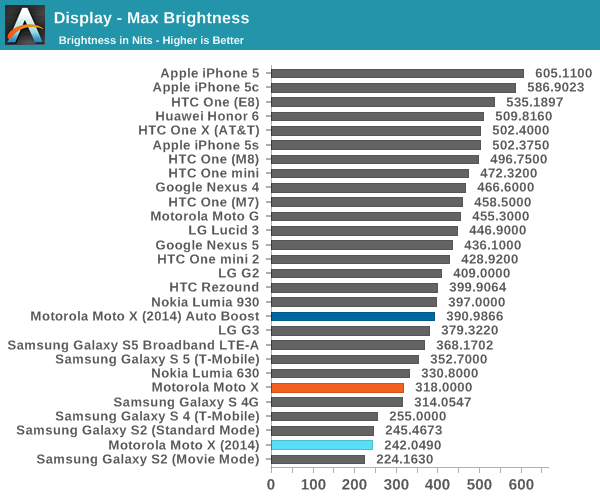
In the basics, the new Moto X is a bit on the low side. While AMOLED has traditionally struggled with luminance in situations such as the web browser and light-themed applications, Samsung’s Galaxy S5 and S5 LTE-A Broadband have shown that it’s possible to achieve levels of brightness approaching some of the brightest RGB-stripe LCDs. As the brightness of the Lumia 930 is about equal to the new Moto X, I suspect we're looking at the Galaxy S4/Note 3 generation of panels. This seems to be backed up by pictures of the subpixel layout seen below as the green subpixels seem to be noticeably larger when compared to the Galaxy S5's panel.
Contrast is still incredible, but I can still see the purple smearing effect that comes from unlit to lit pixels. I’m still unable to get a clear answer on why this is, but it’s likely that capacitance somewhere in the system is causing this issue in the form of RC delay. Whether this is a fixable issue is something I’m not aware of yet. The clear solution would be to set black to the lowest possible brightness a lit pixel can be, but this would make for worse contrast.

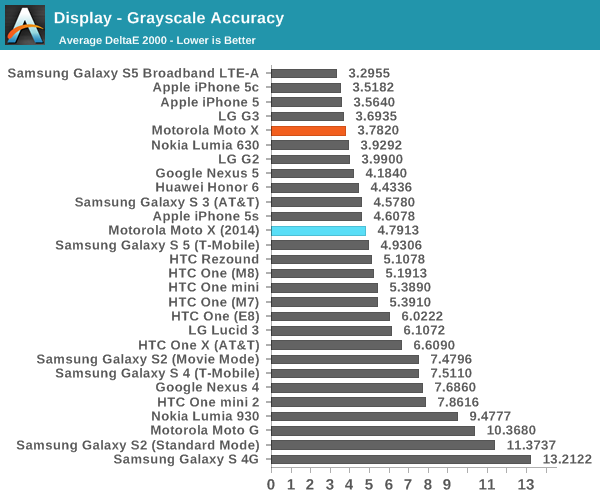
In grayscale, the new Moto X isn’t the best. We see that the display is just a bit too red, and that most of the luminance is coming from red and green. This makes sense from a power and display lifetime perspective though, as blue tends to have the least efficient emitter material in an AMOLED display. However, this translates to poor grayscale performance. The green tint tends to show itself in certain shades of grayscale as well.

In our saturation sweep, the new Moto X continues to be rather poor in its performance. While on Samsung phones it’s normal to see colors like this on the default display mode, there’s usually a mode that correctly constrains the display to sRGB which is the industry standard for displaying colors. There’s no such mode on the new Moto X, so the display significantly overshoots sRGB. This doesn’t bode well for the ColorChecker, which provides the most thorough look at color accuracy.
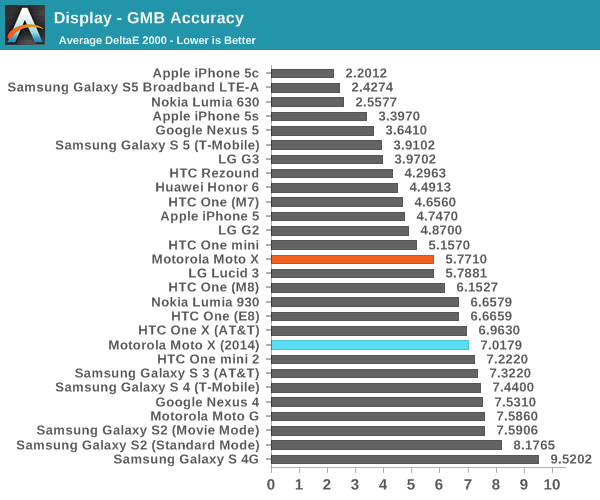
As predicted, the new Moto X does poorly in the ColorChecker. There’s really not much that the Moto X can accurately display in sRGB as just by pushing the gamut too far, even if there wasn’t saturation compression for some colors, the large gamut will cause distortion of all colors within the gamut triangle.
Unfortunately, it’s not clear where this lack of attention to color accuracy comes from. In discussions with Andrei it's clearly possible to calibrate the AMOLED panel from the GS4 quite accurately, and there's no real technical limitation for AMOLED to lack good calibration. However, judging by the relatively low peak brightness there are other issues as this could affect Motorola's performance in battery life tests. This seems to suggest that Motorola is unable to access the latest generation of AMOLED panels from Samsung Display.
This would be a rather startling thought, as it means that no matter what Motorola does to improve their implementation of Samsung’s AMOLED displays, they will always be behind the curve. If it becomes clear that Samsung’s AMOLED is the best display from a user-facing standpoint, every other OEM will face significant barriers in competition as they would be unable to access the latest generation AMOLED panels. The real solution here is for other display manufacturers such as LG, JDI, and AUO Optronics to catch up.
At any rate, the display of the new Moto X seems to be relatively poor compared to what we see in the Galaxy S5 LTE-A (and likely the Note 4), along with the iPhone 5s, Nexus 5, and One (M7). While it’s impossible to ignore the power advantage of AMOLED when implementing functions like Moto Display, the relatively low peak brightness and poor color accuracy are concerning.


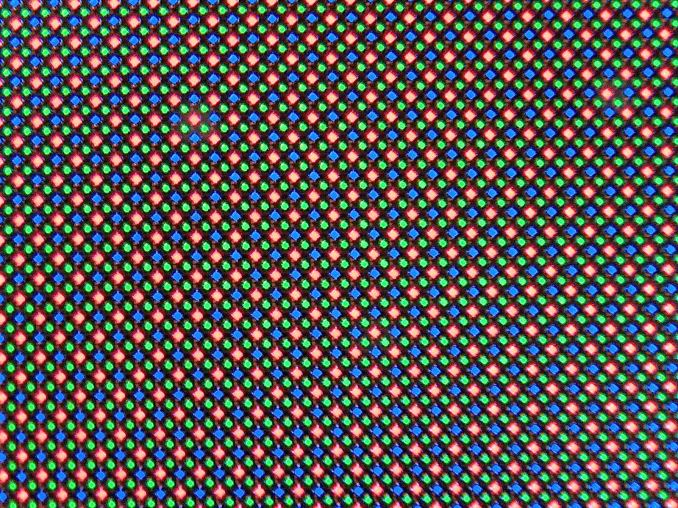

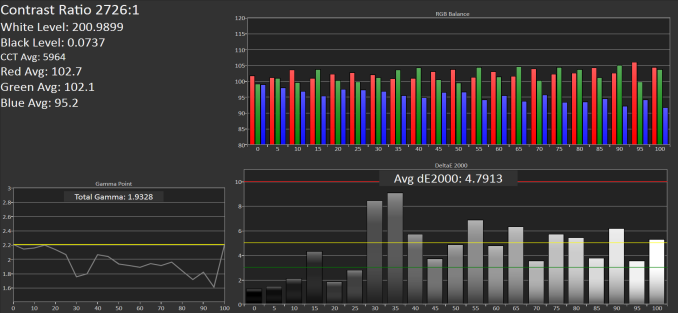

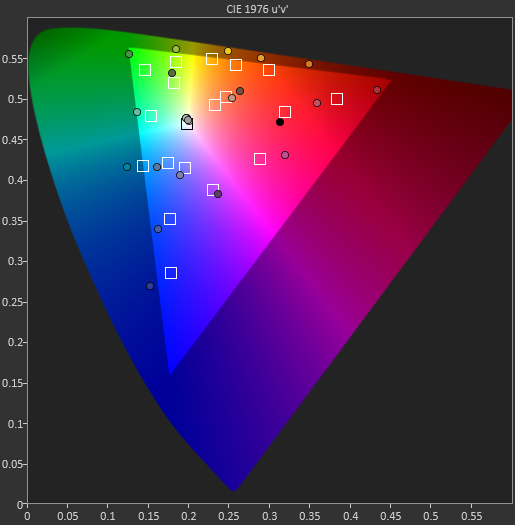








179 Comments
View All Comments
BGQ-qbf-tqf-n6n - Wednesday, September 17, 2014 - link
There have been multiple articles on the tech press regarding Brian Klug also being hired by Apple. Recent "wish I could comment" tweets post-iPhone release seem to support this.melgross - Thursday, September 18, 2014 - link
No, he went to apple about a year ago.Impulses - Wednesday, September 17, 2014 - link
I still his Twitter account is still active, his hobby site hasn't seen many updates but it never did. I miss his insights, always found it very on point, but Joshua is doing a good job...Tho I'm now wondering what his preferred Android UI is (Sense?), since he made a comment along the lines of "AOSP isn't my preferred Android UI" in this article.
soccerballtux - Thursday, September 18, 2014 - link
+1 he really left us hanging. what does he like? what should I?Impulses - Monday, September 22, 2014 - link
I actually meant I'm wondering what Joshua's logged l preferred UI is, since he made that comment I alluded to in this review. I think Brian had a preference for cleaner Nexus/Moto devices, tho Sense's value seems to ebb and flow in between Sense/AOSP releases.svan1971 - Wednesday, September 17, 2014 - link
"While the actual ROM itself seems to have some stability issues such as reboots, app crashes, and other oddness, the functionality is fantastic." its the need to make comments like this that caused me to switch to apple after 4 years of being apart of the droid collective...I will not be assimilated !fokka - Wednesday, September 17, 2014 - link
i'm actually surprised that this statement is not elaborated on some more. you should be able to expect a new flagship phone to work without random reboots and "other oddness" in 2014, even on android.hansmuff - Wednesday, September 17, 2014 - link
So I also wish there was more elaboration on this.Is it typical for the ROMs to get updated as they fix bugs? If so, that would mean older phone revisions would need patches to replace ROM code, taking up RAM.
How is this handled in the smartphone world?
Zoomer - Monday, September 22, 2014 - link
ROM is kind of a misnomer nowadays since it's actually stored in flash. Though one could argue that it's software enforced ROM since most phones with locked bootloaders / no root desn't allow writes to system.JoshHo - Wednesday, September 17, 2014 - link
I'm reluctant to make any final judgments on the stability of software as I was told to expect a launch day OTA.